
The United States' S-class submarines, often simply called S-boats, were the first class of submarines with a significant number built to United States Navy designs. They made up the bulk of the USN submarine service in the interwar years and could be found in every theater of operations. While not considered "Fleet Submarines" in the traditional sense of that term, they were the first submarines in the USN designed for open ocean, blue water operations. All previous submarines had been intended for harbor or coastal defense. These boats were intended to have greater speed and range than previous classes, with improved habitability and greater armament.

USS S-48 (SS-159) was the first submarine in the fourth group of S-class submarines of the United States Navy.
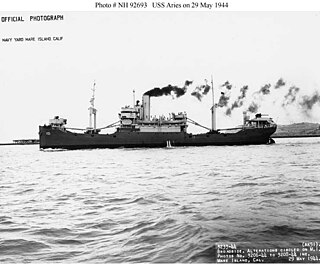
USS Aries (AK-51) (1918–1952) was a United States Navy cargo ship built as Lake Geneva under a United States Shipping Board (USSB) contract in 1918 at Duluth, Minnesota, by the McDougall Duluth Shipbuilding Company, to augment American logistics capability during World War I. The freighter was delivered to the Navy at Montreal, Quebec, Canada, on 21 September 1918 and was placed in commission the following day for service in the Naval Overseas Transportation Service. Aries was named for the constellation.

SM U-151 or SM Unterseeboot 151 was a World War I U-boat of the Imperial German Navy, constructed by Reiherstieg Schiffswerfte & Maschinenfabrik at Hamburg and launched on 4 April 1917. From 1917 until the Armistice in November 1918 she was part of the U-Kreuzer Flotilla, and was responsible for 34 ships sunk (88,395 GRT) and 7 ships damaged.

The first USS Theodore Roosevelt (ID-1478) was a United States Navy troop transport in commission from 1918 to 1919.
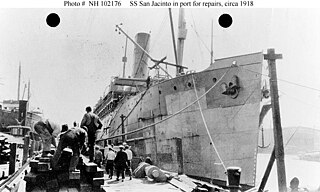
SS San Jacinto (ID-2586) was an American commercial passenger-cargo ship chartered by the United States Army for World War I service and considered for acquisition by the United States Navy as USS San Jacinto (ID-1531).
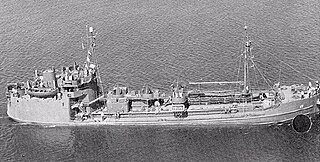
The T1 tanker or T1 are a class of sea worthy small tanker ships used to transport fuel oil before and during World War II, Korean War and Vietnam War. The T1 tanker classification is still in use today. T1 tankers are about 200 to 250 feet in length and are able to sustain a top speed of about 12 knots. The hull designation AO is used by the US Navy to denote the ship is a T1 oil tanker and AOG that the T1 is a gasoline tanker. The small size allows the T1 to enter just about any sea port or to anchor around a small island, this was very useful during the Pacific War. The T1 tanker can carry about 48,000 to 280,000 bbls. Some T1 tankers were used to transport goods other than oil, a few were used for black oil-crude oil, diesel, chemicals and rarely bulk cargo like grain. T1 tankers are also called liquid cargo carriers. The T1 tanker has about a 6,000 to 35,000 deadweight tonnage (DWT) of cargo. The small size also gives the ships short turn around time for repair, cleaning, loading and unloading. A T1 tanker carrying dirty cargo, like crude oil needs a few weeks of labor to clean before carrying clean cargo. Most T1 ships during World War II were named after major oil fields.

The Type B ship is a United States Maritime Administration (MARAD) designation for World War II barges. Barges are very low cost to build, operate and move. Barges were needed to move large bulky cargo. A tug boat, some classed as Type V ships, could move a barge, then depart and move on to the next task. That meant the barge did not have to be rushed to be unloaded or loaded. Toward the end of World War 2, some ships that had not been completed in time for the war were converted to barges. US Navy barges are given the prefix: YWN or YW. Due to shortage of steel during World War II, concrete ship constructors were given contracts to build concrete barges, with ferrocement and given the prefix YO, YOG, YOGN. Built in 1944 and 1945, some were named after elements.

The Type V ship is a United States Maritime Commission (MARCOM) designation for World War II tugboats. Type V was used in World War II, Korean War, and the Vietnam War. Type V ships were used to move ships and barges. Type V tugboats were made of either steel or wood hulls. There were four types of tugboats ordered for World War II. The largest type V design was the sea worthy 186-foot (57 m) long steel hull, V4-M-A1. The V4-M-A1 design was used by a number of manufacturers; a total of 49 were built. A smaller steel hull tugboat was the 94-foot (29 m) V2-ME-A1; 26 were built. The largest wooden hull was the 148-foot (45 m) V3-S-AH2, of which 14 were built. The smaller wooden hull was the 58-foot (18 m) V2-M-AL1, which 35 were built. Most V2-M-AL1 tugboats were sent to the United Kingdom for the war efforts under the lend-lease act. The Type V tugs served across the globe during World War II including: Pacific War, European theatre, and in the United States. SS Farallon, and other Type V tugs, were used to help built Normandy ports, including Mulberry harbour, on D-Day, 6 June 1944, and made nine round trips to Normandy to deliver Phoenix breakwaters.
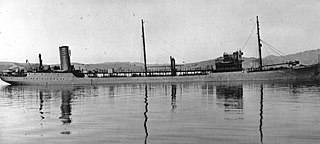
H.M. Storey was an oil tanker built in 1921. She escaped an attack in California in 1941, but was sunk in an attack in 1943. She was owned by Standard Oil Company of California and built by Bethlehem Shipbuilding Corporation at the Alameda Works Shipyard with a hull# of 5312. She had a max. capacity of 306,115 gallons of fuel oil. Her keel was laid on January 19, 1921 and she was launched on September 28, 1921. Her sister ships are the SS F.H. Hillman and SS W.S. Rheem. She had a range of 7,717 miles, 10,763 DWT and a 16,000 ton displacement. She had a length of 500 feet, a beam of 68.2 feet and a draft of 30 feet. She had 2,700 hp, made by a triple-expansion engine with dual shaft and 2 screws. She had three Scotch boilers. Named for Henry Martin Storey, vice president of the Standard Oil Company.
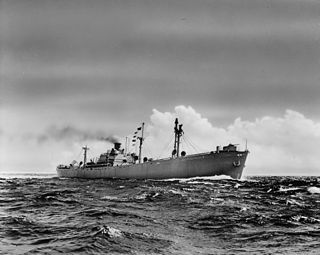
SS Anne Hutchinson was a Liberty ship built by the Oregon Shipbuilding Company of Portland, Oregon, and launched on 31 May 1942 The ship was named after the Anne Hutchinson, a 1600 Massachusetts Bay Colony Puritan.

SS Cynthia Olson was a cargo ship originally built in Wisconsin in 1918 as the SS Coquina. Renamed in 1940, in August 1941 she was chartered by the US Army to transport supplies to Hawaii. While in passage between Tacoma, Washington and Honolulu on December 7, she was intercepted by the Japanese submarine I-26, which sank her with gunfire. Although the commander of the submarine ensured that all of the crew had escaped into boats, none of them were ever found. Cynthia Olson was the first United States Merchant Marine vessel to be sunk after the entry of the United States into World War II.


SS Barbara Olson was a cargo ship built in Wisconsin in 1918 as the SS Corrales. Barbara Olson was able to escape an attack off the coast of California in the early days of World War II. The Barbara Olson was built under a United States Shipping Board (USSB) contract in 1918 as the SS Corrales and renamed in 1940. On July 25, 1942, she was chartered by the US Army to transport supplies to the Territory of Hawaii as the USAT Barbara Olson for World War II. On January 14, 1946, her Army service ended. In 1964 she was run aground four miles (6.4 km) north of Pimentel, Peru and declared a total loss.


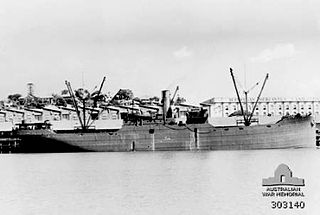
SS Coast Trader was built as the cargo ship SS Holyoke Bridge in 1920 by the Submarine Boat Company in Newark, New Jersey. The Coast Trader was torpedoed and sank 35 miles (56 km) south west of Cape Flattery, off the Strait of Juan de Fuca in U.S. state of Washington by the Japanese submarine I-26. Survivors were rescued by schooner Virginia I and HMCS Edmundston. She rests on the ocean floor at.

A. H. Bull Steamship Company was a shipping company and passenger liner service founded in New York City in 1902 by Archibald H. Bull (1848-1920). Service started with shipping between New York and Florida. His fleet of ships then added service to other Eastcoast ports. The company is also often called the Bull Lines and the Bull Steamship Line or A. H. Bull & Company. While founded in New York, Bull soon move its headquarter to Peir 5 in Baltimore, Maryland. Bull Lines main Eastcoast ports were: Baltimore, Charleston, Philadelphia, Tampa and Norfolk, Virginia. Oversea ports: Porto Rico, Antwerp, Bordeaux, Hamburg, Bremen, Copenhagen, and West Africa. Bull Steamship Line supported the US war effort for both World War I and World War II, including the loss of ships.






















